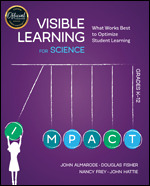Visible Learning for Science, Grades K-12
What Works Best to Optimize Student Learning
- John Almarode - James Madison University, USA
- Douglas Fisher - San Diego State University, USA
- Nancy Frey - San Diego State University, USA
- John Hattie - The University of Melbourne, Australia
In Visible Learning for Science, the authors reveal that it’s not which strategy, but when, and plot a vital K-12 framework for choosing the right approach at the right time, depending on where students are within the three phases of learning: surface, deep, and transfer.
Synthesizing state-of-the-art science instruction and assessment with over fifteen years of John Hattie’s cornerstone educational research, this framework for maximum learning spans the range of topics in the life and physical sciences. Employing classroom examples from all grade levels, the authors empower teachers to plan, develop, and implement high-impact instruction for each phase of the learning cycle:
Surface learning: when, through precise approaches, students explore science concepts and skills that give way to a deeper exploration of scientific inquiry.
Deep learning: when students engage with data and evidence to uncover relationships between concepts—students think
Transfer learning: when students apply knowledge of scientific principles, processes, and relationships to novel contexts, and are able to discern and innovate to solve complex problems.
Visible Learning for Science opens the door to maximum-impact science
Free resources
Prompts for Facilitating Students Self-reflection and Metacognitive Awareness
Use this self-reflection model from Visible Learning for Science, Grades K-12, as a follow-up technique once a lesson has occurred that helps students understand where they were and where they are now.
Visible Learning for Science: Feedback Strategies
Use this complimentary excerpt from Visible Learning for Science, Grades K-12, to learn powerful feedback strategies that you can use to impact your students’ science learning.
Hugging and Bridging Methods for Low-Road and High-Road Transfer
Use these hugging and bridging methods from Visible Learning for Science, Grades K-12, to promote low-road or high-road transfer based on where your students are in their learning journey.
Webinar: From Labs to Lifelong Learners
Unpack with John Almarode, author of Visible Learning for Science, Grades K-12, the different strategies that best support visible learning in the science classroom.
“The authors have written a book with research to support that various learning techniques are effective at different times. Its lack of ‘an all or nothing’ approach truly impresses. This book reminds teachers to make relevance obvious when teaching science standards and that mistakes are necessary for learning to occur. It is so relevant in today’s school climate and is an easy read for busy teachers who are trying to do the best they can for their students.”
“Visible Learning for Science is a great science methods text with its many, many great examples and excellent inclusion of research. I would definitely use this book in the classroom!”
